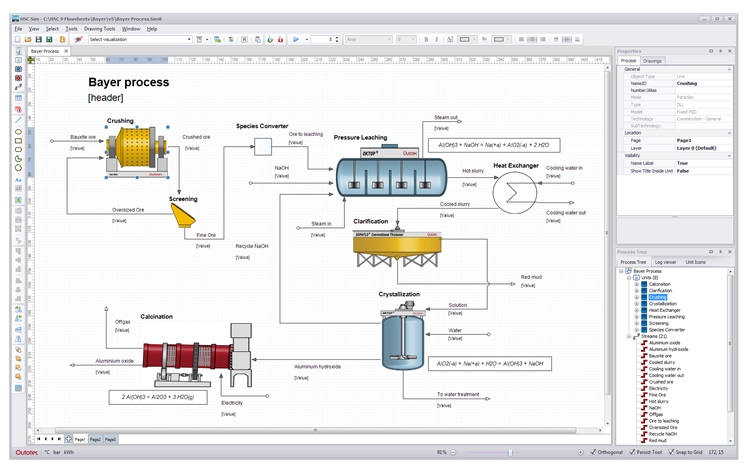Outotec says it has upgraded its HSC Chemistry® process modelling platform with new features, faster operation, and an improved user interface.
Outotec HSC Chemistry is widely used in the metallurgical and chemical industry and universities for R&D, process design and training workshops, according to Outotec, with the latest version being the result of more than 50 years of development, hundreds of hours of discussions with end users and decades of industry experience.
“It is truly a state-of-the-art process simulation package that seamlessly integrates into the wider metallurgical and chemical engineering process design environment,” the company said.
Metallurgical and chemical process technology must always be tailored to the local raw materials, energy sources and legislation, as the ores and secondary raw materials are unique at every site, Outotec says.
“Process flowsheet modelling is the basic tool, which makes it possible to optimise process recoveries, grades, OPEX, CAPEX, KPI guarantees, engineering data, environmental footprints, etc,” the company added.
The HSC Sim module is able to simulate the whole lifecycle of metals and chemicals including mineral processing, smelting, hydrometallurgical refining, precious metals recovery, and recycling, according to Outotec. “With HSC, a process designer can create a competitive and sustainable process.”
HSC LCA (Life Cycle Assessment) tools make it possible to understand and optimise the process, not only from the technical and economic point of view, but also considering the environmental impact. “It is critical to do this at the process design stage as it is difficult and expensive, if not impossible, to make changes after the engineering, construction, and start-up stages,” Outotec says.
HSC also acts as a basic R&D tool, which decreases the amount of expensive trial-and-error chemistry, Outotec says. “The experiments can be wisely designed before costly laboratory and pilot test campaigns. HSC also provides a lot of benefits in the analysis stage of the research work, and finally converts valuable experimental results into an easy to use digital format,” the company said.
Universities widely use HSC in workshops, because HSC offers versatile tools for various stages of education, according to Outotec. “Methodological skills related to modelling and simulation create connections between theory and practice, which helps students to understand the role and relevance of theoretical studies when they have a chance to apply their theoretical knowledge in real-life related problems using tools that are actually used in R&D projects.”
The HSC 10 top new features, according to Outotec, include:
- New subscription-based licensing replaces old perpetual licensing;
- HSC 9 calculation module files are upward compatible with the new HSC 10;
- Sim Model Base expands personal expertise to organisation expertise;
- Sim Model Optimization with Monte-Carlo, PSO, Simplex, MFit (SQP);
- Sim Model Convergence Monitor for static models;
- Sim Dynamic Report is a new tool for collecting simulation data;
- Sim file loading and calculation speed improvements;
- Sim Unit Operation Protection;
- Sim model combination improvements;
- Sim OpenLCA dialog improved and updated;
- Sim new generic unit operations;
- Gem Equilibrium Module: Own Pitzer parameters, electrode potential calculations;
- Aqua Module with own Pitzer database;
- New Sampler Module with save/open features;
- Diagram Navigator Module: new triangulation algorithm and several small improvements;
- Data Processing Module with new algorithms and faster graphics;
- Material Database Module with links to location maps;
- HSC Main Database Module with new and updated data for chemical species; and
- HSC Main Menu with Sub Menu.











